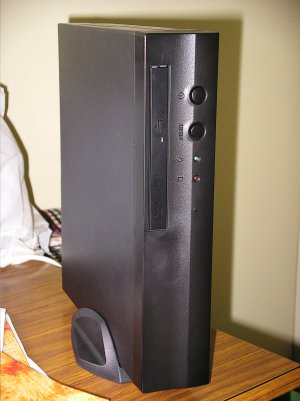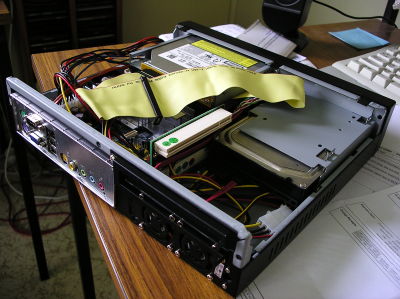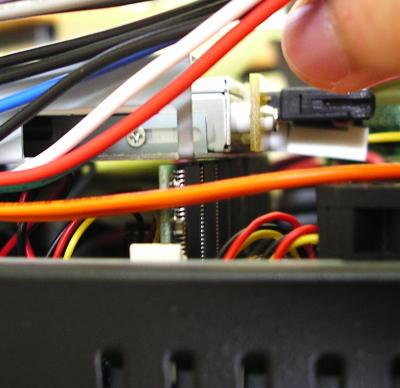It started with an impulse purchase. I was browsing Harvey Norman for one reason or another (I was probably in there to buy some overpriced printer ink) when I stumbled across the TV tuner card aisle. I had been digital-TV-curious for a while—this at a time when digital-TV was still fairly recent—and I was in a buying mood, so I bought a single-tuner DviCo PCI HDTV card. It took a bit of effort to get the software right, and I had to also get myself a long TV aerial cable, but it wasn't too long until I got working TV on my computer.
It was at this point that strange and wonderful ideas began to form in my head. Words like “MythBox” and “PVR” and “TiVo” coalesced, loitered around menacingly, and formed gangs that beat up other words like “easy”, “sensible” and “cheap”.
I considered for a moment what I already had to work with. I had an nVidia video card with, supposedly, video out function. I say “supposedly” because, at the time that I tried it, nVidia's Linux drivers were a bit thin on this particular front. TV out would kinda-sorta work, I think, but probably wouldn't be capable of handling anything tricky like hanging an alternate display off it.
What I also had, though, was an old DVD decoder card: a Sigma Designs Hollywood Plus (H+). This had been working well under Linux for several years using the dxr3 drivers. Knowing that the TV signal is actually an MPEG2 stream much like a DVD stream, I figured there must be a way to connect it, the DVB card, and my TV under MythTV.
There wasn't, though. Not with MythTV. MythTV assumes you have a true framebuffer to work, and the dxr3 driver doesn't implement a true framebuffer. But I did find an alternative to MythTV that could do what I wanted: VDR.
VDR is perhaps not the prettiest, most feature rich, or easiest to use PVR software available. Don't get me wrong, it's very good, but at the time it was not as intuitive and ubiquitous as MythTV. It does have one major advantage, though—it supports the H+ card well, via the dxr3 plugin.
After finally figuring out how to actually do cool things in VDR, I was really impressed with what I could then do: record, timeshift, pause live programs, get program info, etc. All with vastly improved picture quality, to boot, compared to my old analog signal. (There was probably an improvement in audio quality too, but the speakers in my TV are extremely ordinary anyway, so that advantage was somewhat moot.) It was a big step up from what I was able to do previously, which was precisely none of those things, and typically with a fuzzy picture.
It didn't take long before I got completely used to using VDR as my PVR, but there were still a few things about my particular setup that were bugging me. My computer lived in my bedroom, and the TV lived in an adjacent room. I needed to have fat, long cables running across a doorway to get signal from the aerial to my computer, and then picture and sound from my computer to the TV. (For some reason the best place in the house for reception by my indoor aerial was literally on top of the television. Who would've guessed?)
The second thing that was bugging me was having to boot-up and shutdown my computer every day just to put something on the idiot box. This was getting annoying. The alternative, of course (short of having the machine wake itself up, which it seemed unable to do by that point), was to leave my machine running overnight, all the time. This would have the advantage beyond just not having to turn it on in the morning, but also that it would be able to record things that interest me even after I'd have gone to sleep.
The problem with that idea, though, was that my computer sounded like a lawnmower. An old rickety case housing some 80 mm fans and the whole setup never considered for quietness, sitting a couple of meters across from my bed, made for an uncomfortably noisy environment that I would have had to try to sleep in.
Then I had a thought (uh oh) which seemed like a fun idea (oh no). “Why not build a quiet, efficient little machine, a kind of MythBox, exclusively to run MythTV-type software and handle all my TV needs?”
I should've just had a lie down and forgotten about it. But instead of doing the sensible thing, I spent a couple of weeks of my holidays feverishly searching the web for information about what I could do to achieve said box. I discovered the MiniITX form factor and was intrigued. Looking around to see what I could practicably get my hands on and what would do the tasks I was proposing, I took copious notes, comparisons, and details.
I had originally foreseen a fanless (and thus extremely quiet) system, with huge hard drive capacity, about the physical size of a DVD player, that would sit on top of my TV, run MythTV 24 hours a day, and record TV, play DVDs, and generally be my super-duper custom-built media centre.

What I actually ended up with was a little bit of a compromise from this ideal—disappointingly I was unable to work out a fanless configuration. The final plan involved a twice 40 mm-fanned (and thus, not so quiet) case—a Morex Procase 2677—and 40 mm-fanned (again, not so quiet) motherboard—a VIA EPIA SP-13000. But, on the plus side, the motherboard had MPEG2 hardware acceleration and TV out, and I was getting a huge 400 GB Sumsung hard drive for storage of recordings and things. I was also getting 512 MiB of 30 mm-tall RAM—importantly, my copious reading revealed that this particular case literally can not fit any RAM that's taller than 30 mm, so I made sure to check the RAM manufacturer's (PQI's) website for specifications before I ordered anything. Some parts I got from AusPCMarket, others from Eyo. The parts all totalled more than AU$800, but my newly approved Australian Postgraduate Award meant I could afford it. (I'm rich, ha ha! ...Not really.)

The parts arrived sometime in the following week. On the night they arrived, I took them all out and started assembling everything. It didn't take long before I ran into my first problem: The RAM was too tall. A single millimetre too tall. I measured it. Somebody (PQI) lied to me. I was not happy at all.
For now, it just meant that I wouldn't be able to put the DVD drive in its proper place, so I plugged the RAM in anyway. That let me get to the stage of booting something for the first time, and, with Debian install CD in the drive... nothing but motherboard beeps. After some farting around with various things, I eventually worked out that the RAM itself, quite aside from being too big to fit properly, was also DOA.
It occurred to me (after the obvious disappointment and mild rage), “Perhaps I could get Eyo to change it to a RAM stick only 30 mm tall while they replace this bad stick—kill two birds with one stone.” This assumed, of course, that the guys at the other end would actually listen to what I was asking (or even believe me) and actually wanted a satisfied customer, not merely a paid-up one. Ultimately I had assumed incorrectly.

In the meantime, I stole a stick of RAM from my desktop machine which just happened to actually be 30 mm tall. It also happened to be matched to a second stick in a dual-channel configuration, so I wasn't keen on this being a permanent solution, but it was enough for the moment.
Over the next while, I installed Debian and MythTV and played around a bit with all that. After much tweaking and farting around I got to the stage of actually being able to watch TV through it. Only, the reception wasn't all that good. Or, more accurately, it was pretty bad—enough to fall right over the digital cliff.
I don't recall exactly how I worked it out—I probably put the TV card back into my desktop machine a tried some things there—but I eventually discovered that, somehow, the DC power block for the Morex case was causing so much electromagnetic interference that my indoor aerial was not enough to get a sufficiently strong signal above that noise for the tuner card to lock onto. I could only get, at best, one channel at a time, so long as I oriented the aerial just perfectly, and that required me reorient the aerial whenever I wanted to change channels. Some channels weren't able to be picked up at all.
In the end, the only time my MythBox would have a clean enough signal to be able to do what it was originally built for was when the whole thing was switched off... at the wall... Brilliant.
It probably would have been enough if I had an outdoor aerial. But I didn't, and for various reasons, I wasn't about to install one. All this was taking place, of course, while I was exchanging emails with the folks at Eyo, where I bought the RAM from, trying to nicely ask them to help me find a stick of RAM really-truly 30 mm tall, and not taller. Pretty much the only response I got through that whole exchange was “Tell us which one you want, and we'll exchange it, for a 15% restocking fee.” Even when I replied specifically saying that I just want one that's 30 mm tall: “Tell us which one you want, and...” Genius.
I was trying to make it clear what I wanted to do: return a stick of RAM that was dead on arrival and at the same time exchange the RAM for something more appropriate, which they would be kind to suggest. I didn't see why I should pay the full restocking fee since, to replace the dead RAM (for which that restocking fee doesn't apply), they'd surely have to go through almost the same motions, anyway.
It was nearing the end of December at this point, and their website claimed they would be leaving on holidays for a few weeks over Christmas. I sent yet another email with the same request, reworded yet again to try to make the point clearer, and when I didn't hear back within a few days I assumed they had left for the holidays and would deal with me again when they all got back in the new year. Over the holidays I looked at what I might be able to do to alleviate the problem with the interference, but that exercise didn't produce anything useful. (Turns out aluminium foil doesn't make such a good electromagnetic shield, though I should've guessed.) It was about at this time when I realised this project was doomed.
It was the new year now, and the guys at Eyo still hadn't gotten back to my last email. Fed up, I emailed them requesting an RMA to return the dead RAM and that, as per their own policy available on their website, they refund it rather than replace it. I got the RMA without hassle and posted the RAM back.
About a week and a half later I got a phone call to my mobile from a guy at Eyo. They were still confused about my situation and what I wanted to do. The call was to let me know that my replacement RAM was ready to be shipped. Yes, they wanted to send me a replacement stick of RAM. (Are these guys illiterate?)
I argued with him for several minutes about not wanting a replacement. He wanted to charge me the full restocking fee. Restocking is not applicable to dead items. He argued that I was late with notifying them. I had notified them within a couple of days of the RAM arriving here—it was their fault that it had taken so long to go ahead and do something about since they made no effort to help me choose a replacement or alternative, and the ball only got started rolling once I inevitably just gave up dealing with their crap. He wanted to at least charge me something, since RAM prices had shifted by this point.
I was sick of arguing and conceded to some small amount being taken off the refund amount. I forget how much, but it was less than the total 15% restocking fee. The amount was credited to my card shortly after. I won't be purchasing anything from Eyo again.
As for my MythBox, for a while its remains occupied space in my spare room. I couldn't use the box because it made too much electromagnetic interference, so it was entirely useless to me at that point.
After some time and some calming down, I thought some more about it and realised that the biggest problem I had with the old system in my loud machine was really the fact that my machine is loud. The other problems were minor—the cables can be taped to the floor for minimal fuss, and everything else pretty much just works.
“So why not,” I thought, “instead of a separate, quiet machine, I replace the loudest component of my machine, the PSU, and get a new quiet case to use? That way, I could leave my machine running 24 hours a day and still be able to sleep. And there's the bonus that this way, once I eventually upgrade from dial-up to broadband, I'll be able to use my machine as a little always-on server, too!”
You would think I would've learned to steer well clear of those kinds of thoughts by now, but you'd be wrong. It foreshadows a whole new set of bizarre problems that drove me mad for another month. Read about them in my follow-up post: My Homebuilt Personal Video Recorder Nightmare 2: Peace And Quiet.
Comment to add? Send me a message: <brendon@quantumfurball.net>